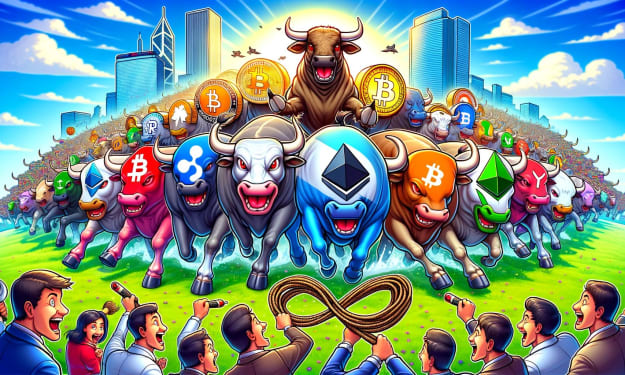Creating for Creation's Sake
You don't need rich parents to make art

We should do away with the absolutely specious notion that everybody has to earn a living. It is a fact today that one in ten thousand of us can make a technological breakthrough capable of supporting all the rest. The youth of today are absolutely right in recognizing this nonsense of earning a living. We keep inventing jobs because of this false idea that everybody has to be employed at some kind of drudgery because, according to Malthusian Darwinian theory he must justify his right to exist. So we have inspectors of inspectors and people making instruments for inspectors to inspect inspectors. The true business of people should be to go back to school and think about whatever it was they were thinking about before somebody came along and told them they had to earn a living.
- Buckminster Fuller
When We Are
Social tokens are a cue of the internet's evolution from Web 1 (read-only) to Web 2 (read and write) to Web 3 (read, write, and value). If you could plot the fulfilment of every person's creative capacity through time, it'd be this:

Creativity is at all-time highs and growing.
Content used to be a one-way street. Studios produce content for film, TV, radio, and literature, and audiences consume it with little to no say in the substance of the content itself. Intermediaries tend towards gum flapping over rational discussion because that's how they optimize for profit.
Pushing our emotional buttons gets more views than critical thought, but there's gotta be sizzle and steak!
Rational discussion is debatably more prevalent after YouTube. Now it's normal to share in the ideas, beliefs, and goals of thousands of people, but creation for creation's sake has always been an antibusiness model. A lot of money obviously follows an epic movie, but life-crushing debt follows most failures.
Most of the content we consume today doesn't come from studios with 8-figure budgets but from individuals on smartphones who we as patrons selectively consider. Satellite might have 1000 channels. YouTube, Instagram, Twitch, and TikTok have over 50 million.
This new medium elevates "engagement" to "connection" by including the audience in the creative process. A trend starting with choose your own adventure books and Black Mirror: Bandersnatch is now live streaming globally.
Media is now bidirectional. You, watching the content, have the power to interact and influence in real-time the creator, and therefore the content you engage with. Bonkers.
If my rave crush Andy C distributed coin at his concerts and built DeFi around it, there might be a yield farming strategy that pays to go dancing. BONKERS!
Social tokens introduce the next dimension to the culture of creativity - value. Specifically, the value of enabling creators to focus all their energy on making more of what their fans love.
How to Give More
Before going into the process of designing a mutually beneficial transaction, we should recognize that the express purpose of social tokens implies that holders will care about doing what they love with people on their wavelength more than they care about price performance. The digital asset itself is an arcade token. Acquisition is an investment in the creator, not the item, roadmap, or tokenomics, regardless of technicals and fundamentals.
There's a lot of overlap here with NFTs opening new ways for creators to connect directly with their fans without going through a record company's legal pitbulls.
We all eat, so how do creators make money these days without blockchain?
There're record deals, but that's a lot of delayed gratification.
There's pay-per-read (PPR) through platforms like Medium, Vocal, or Carbon, which even integrates tipping via ERC-20. But that gratification is so delayed gratification the creator risks becoming their own wage slave. Besides, relying on tips is not a secure business model for most types of work.
Advertising breadcrumbs, but that has all the same pitfalls as PPR.
Partners, sponsors, and affiliates are lucrative as hell, but that does nothing to help new creators with smaller audiences.
Then there's merchandise and e-commerce, but unless we're talking custom handmade items, e-commerce leads back to for-profit instead of for-human-connection.
Having other profitable businesses running on their own is really the only way to create for creation's sake. For most agricultural history, the only artists were either born rich, working part-time in the equivalent of today's hospitality industry, or literally starving for their art. And most often, their work is never recognized as exceptional until they're dead.
All these systems (except the "have money from somewhere else" model) have a commonality: intermediaries. Baking bread requires someone to manage the exchange of value from raw materials to finished product. Helpful, sure, but the middlefolk are motivated, first and foremost, to keep themselves above water. They meet their quota by compromising user experience, which undermines the express purpose of creative endeavour.
NFT's, Hollywood, and Spotify show that creativity can be an efficient business. I believe that rewarding the artist for the value they provide is better done while they're breathing. Creators are very obviously motivated to continue the artistic process, but everyone needs to eat, so not all artists can create full-time.
Social tokens concentrate the economic activity of the art business to the creator while enhancing instead of disturbing the user experience. This isn't about "extracting" value. The game here is about measuring the value already being created.
Creativity in Crypto
Social tokens prompt disintermediation: the removal of parasitic middle-corps whose sole mission is to squeeze every dollar out of every hit song. To be fair, record labels bring experience and a budget to the table. Applying our own "tails we lose a little, heads we win a lot" philosophy, they're effectively guaranteed to recoup 9 losses with 1 win (given enough repetitions). When social tokens become the medium of valuing the creator-audience connection, labels can continue connecting artist and community for a fair price instead of taking >80% of revenue.
Creativity is a mission-driven business. Life Is Good has been spreading optimism via t-shirts since 1994 for the express purpose of helping more people find solace, hope, and happiness through all life brings. Their goal is to facilitate rewarding connections between humans. The money merely supports Bert and John Jacobs in realizing that vision without spending 40 hours a week doing something else.
Rally.io
Maybe all messages could spread via t-shirt, but that's not the medium for every creator. For that, there's Rally. The platform creates space for all communities, whether it's 1000 people or a billion. While smaller creators (<500k followers) need help monetizing their content so their vision can grow, social tokens are really an opportunity for any sized audience.

Unestablished artists no longer have to delay the fruits of their labour until some unforeseeable and uncertain future, and celebrities get the creative freedom to give to their fans what ever how ever, and when ever.
To avoid the conflict of interest inherent between corporations and communities, Rally takes zero fees from creators and their communities. In an interview with the founder of Rally, Kevin Chou, tells us that he wants the Rally network to look and feel like BTC and ETH. Rally ($RLY) is a governance coin. It doesn't exist to collect the value created on the network but to secure its value in decentralization. In providing this service, the value of RLY becomes tied to the value and the volume of activity on the network. Rally wins when creators win. Under the same model, ETH is up over 13000x from its ICO.
Rally was initially funded by Coinbase Ventures but has since found support from over a dozen VC funds. RLY has a max supply of 15 billion tokens that are released over 8 years. 70% of the tokens are allocated to community rewards, liquidity mining, technical partnerships, community partnerships, and more. Seed investor and team tokens are locked for 12 months (starting January 2021) and vest over 4 years. You can read about their tokenomics in greater depth here.
Product-Market Fit
There's also risk. First, there's regulation. Right now, it doesn't really matter what any regulatory body says. The SEC, White House, or Federal Reserve can say whatever they want and it means very little.
That said, social tokens are unlikely to fit the definition of a security because these assets aren't meant to serve as investment vehicles. The implied value of a social token is entertainment.
I welcome regulators to enter our arena. Crypto won't fully integrate with the world outside financial services until the primary user base - people uneducated in blockchain and economics - are comfortable knowing that signing up for a service like Rally doesn't jeopardize their careers, credibility, or fan experience.
Tying the value of a digital asset to the creators' real input is another story. If the creator takes a vacation or is confronted by one of life's unforeseen circumstances, their economy could collapse. And if a young artist launches their token before they hit the mainstream and the token flops, would the artist still be able to make it? Financially? Emotionally? Would they need a new path?
Assuming the platform succeeds and the community grows, it'll really be the creator's economy. So how will they distribute tokens?
There are many open-ended questions that, in principle, don't have definitive answers.
Blockchain is eating the world, so it's only a matter of time until we see brands with the status of Supreme and Beyonce moving on-chain. The main idea of social tokens is to credit creators for the value of their work in perpetuity. If you still have trouble seeing how, imagine it's the year 2042, and you sold fractional ownership of the one-hit-wonder you wrote in 2022. It pays you every month, directly to your ETH wallet, forever, and you don't owe half to an agent.
Social tokens have three primary use cases:
- Protecting access to content and community. Think exclusive access to a musician's unreleased LP, or a monthly Zoom hang with the artist, or access to exclusive collectibles and experiences. Again, there's a lot of overlap here with NFTs.
- Providing a medium for exchange within a community. We can trade with other members to unlock perks, tip the creator, or buy that exclusive collectible. If the creator relies on their work for money, some percent of the max supply can be reserved to pay the creator a salary in a way that doesn't tank the token's price.
- Investing in the success of the creator. The more fans an artist has, the more demand there is for the token, the higher the price goes (as supply is capped). What if, convinced of Kendrick Lamar's lyrical genius in 2013, I bought his coin. Then he wins a Pulitzer Prize for the album DAMN. in 2018.
Participating in social tokens as a community member is easy. You can log in to Rally with a Twitch account for immediate connection to your favourite streamer.
But there are barriers for creators. There's the technical setup of defining a coin's parameters, launching the token, and distributing it amongst your audience. The crypto onboarding means creators won't need to install Metamask to start their economy. Then, a creative barrier: designing a monetary policy.
---
You've just read the free version of our Barely There editorial. Access to this full piece of content, along with all our past and future research and analysis is available exclusively to members of the Private Bear Den. You can get all this alpha and more from our community by foraging with us!
Disclaimer: this content does not constitute financial advice.
About the Creator
Paul Bokserman
Life's long enough to cultivate inner peace and too short not to.
@peacesofpaul on Twitter
Paul Bokserman on LinkedIn
Content & Copywriter to The Arcane Bear






Comments
There are no comments for this story
Be the first to respond and start the conversation.